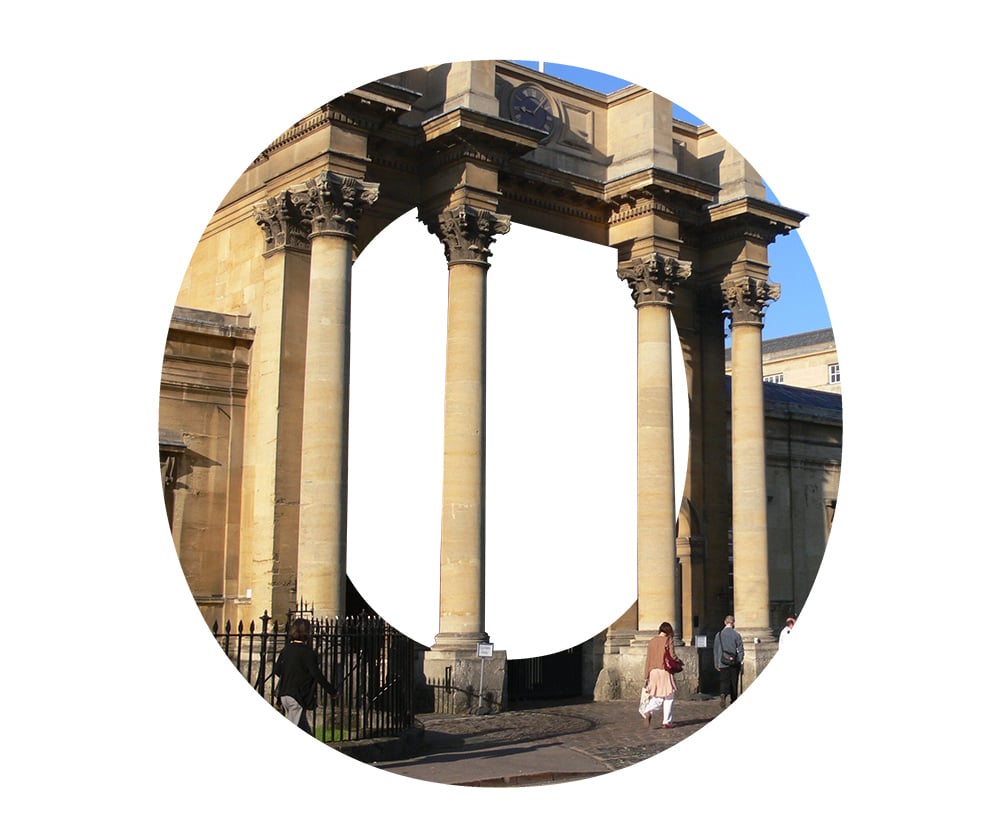A-Z of Oxford
A is for Ashmolean

The Ashmolean is the University of Oxford’s museum of art and archaeology, founded in 1683. The world famous collections range from Egyptian mummies to contemporary art, telling human stories across cultures and across time.
The Ashmolean’s collections are extraordinarily diverse, representing most of the world’s great civilisations, with objects dating from 8000 BC to the present day. Among many riches are the world’s greatest collection of Raphael drawings, the most important collection of Egyptian pre-Dynastic sculpture and ceramics outside Cairo, the only great Minoan collection in Britain, outstanding Anglo-Saxon treasures, and the foremost collection of modern Chinese painting in the Western world.
More info about Visiting the Ashmolean and the Ashmolean's website.
Original image credit: Phil Sayer Partnership.
B is for Boat Races

The boat races are the most famous of the Varsity Matches and have a huge audience on television, radio and online. In 2015, at least 4.8 million people in the UK alone tuned into the women's race and 6.2 million the men's, and on average more than 100 million watch the races worldwide each year. The first boat race was the result of a challenge issued to Oxford by Cambridge in 1829. It was rowed on the Thames at Henley and Oxford were the victors. The first women's boat race took place in 1929.
In 2015, the men's and women's races took place on the same course and the same day, for the first time, and both Oxford crews triumphed.
Today the 4.5 mile course, which was first used in 1845, stretches from Putney to Mortlake. The race is held in March or early April and the average time taken to complete the course is 20 minutes.
Find out more here: http://www.ox.ac.uk/news-and-events/The-University-Year/The-Boat-Races
C is for Colleges

Oxford is a collegiate university, consisting of the central University and colleges. The 39 colleges are self-governing and financially independent institutions, which are related to the central University in a federal system. There are also six permanent private halls, which were founded by different Christian denominations and which still retain their Christian character. The different roles of the colleges and the University have evolved over time. Colleges select and admit undergraduate students, and select graduate students after they are admitted by the University; they provide accommodation, meals, common rooms, libraries, sports and social facilities, and pastoral care for their students, and are responsible for tutorial teaching for undergraduates.
Full list of Colleges and Halls / Colleges and Halls accepting undergraduate students / Colleges and Halls accepting graduate students / visiting information.
Original image credit: Rob Judges.
D is for Divisions

The university's academic departments, faculties and research centres are grouped into 4 divisions: Humanities; Mathematical, Physical and Life Sciences; Social Sciences and Medical Sciences.
Find out more about the Divisions including video overviews and main departments here or view a full A-Z list of all departments, sub-departments, faculties, sub-faculties, institutes, centres and other units at Oxford University.
Original image credit: Rob Judges.
E is for Encaenia

Encaenia is the ceremony at which the University of Oxford awards honorary degrees to distinguished men and women and commemorates its benefactors. It is held annually on the Wednesday of ninth week during Trinity Term.
The Encaenia day traditionally consists of 3 elements: Lord Crewe’s Benefaction in one of the colleges, a procession to the Sheldonian Theatre where the Ceremony takes place, then a Garden Party in one of the colleges. More information about Encaenia here.
Original image credit: John Cairns.
F is for Fellows

Senior members of college who, together with the college head, constitute the governing body. Colleges may also have other categories of fellow, such as honorary or emeritus fellows, who are not members of the governing body. There are also research fellowships of various kinds in the University.
Original image credit: Rob Judges.
G is for Gazette

The Gazette is Oxford University’s official journal of record – it publishes formal notices of appointments and changes to the University’s legislation as well as information about lectures, exhibitions and musical events, classified advertisements and job vacancies around the University and colleges. (It even includes job adverts from Cambridge, for those interested in the other place…)
The Gazette has been published weekly during term since 1870, and, although there’s much less Latin these days, a lot of the notices published in its early years wouldn’t be out of place in today’s editions.
Anyone can read the Gazette online for free at www.ox.ac.uk/gazette and you can sign up to receive weekly emails highlighting content in that week’s issue. Members of staff can also sign up to receive print copies via www.staffsubs.ox.ac.uk.
Original image credit: John Cairns.
H is for Hilary

The University year is divided into three terms, called Michaelmas (October-December), Hilary (January-March) and Trinity (April-June). These are named for the feast of St Michael and All Angels, the feast of St Hilary of Poitiers, and Trinity Sunday, respectively.
The year is also marked by high-profile lectures, events and sports fixtures. Every year honorary degrees are awarded at Encaenia, and the Oxford London Lecture is hosted by the Vice-Chancellor. The Boat Races and the Varsity Cricket, Rugby and Football matches are also held annually.
Original image credit: Jill Walker.
I is for Innovation

From the creation of the Oxford University Press (1586) to the 130+ research-based spin-out companies incorporated since 1988 and the latest ventures in the Startup Incubator, Oxford students and researchers have always shown a talent for innovation and developing an entrepreneurial mindset.
They also apply creative and lateral ways of thinking, connecting and problem-solving to everything from cultural engagement to the student and local community social enterprise projects which the University supports as a partner of The Oxford Hub and Oxfordshire Social Entrepreneurship Partnership.
Original image credit: John Cairns.
J is for Jobs

The University of Oxford, including the colleges and Oxford University Press, is the county’s largest employer. It is responsible for 17,000 jobs and injects £750 million annually into the local economy.
An independent report in 2013 found that spin-out companies from the University of Oxford supported 5,000 global jobs with 1,600 in Oxfordshire (and we have spun-out 21 new companies since then!)
There are over 500 people working in companies and research groups at the University’s Begbroke Science Park and more than 2,400 people in over 60 companies at Oxford Science Park, which is owned by Magdalen College.
Original image credit: Emily Alexander.
K is for Knowledge

A great university conveys the knowledge created by its community while remaining open to new ideas generated elsewhere. Oxford provides an ideal foundation for new interdisciplinary research, combining expertise from the arts and sciences to look at how philosophy can inform medicine, or how civil rights law interacts with literature, among many other examples.
Original image credit: Rob Judges.
L is for Libraries

The Bodleian Libraries make up the largest university library system in the United Kingdom, including 30 libraries across Oxford as well as the central Bodleian Library, which has been a legal deposit library for 400 years. Together, the Libraries hold more than 12 million printed items, over 80,000 e-journals and outstanding special collections including rare books and manuscripts, classical papyri, maps, music, art and printed ephemera. Members of the public can explore the collections through the Bodleian’s online image portal at digital.bodleian.ox.ac.uk or by visiting the exhibition galleries in the Bodleian’s Weston Library.
Original image credit: David Williams Photography.
M is for Museums

Oxford’s museums attract visitors from around the world and provide a rich resource for the University and the community. Together they span thousands of years of human history, from art and antiquities at the Ashmolean Museum to the anthropological collections of the Pitt Rivers Museum, which holds objects and artefacts from hundreds of cultures around the world. The Bate Collection of Musical Instruments celebrates the development of musical instruments from medieval times to the present day, while the Museum of the History of Science contains the world’s finest collection of early scientific instruments. The Museum of Natural History is perhaps most famous for its dodo remains and dinosaur fossils, but also holds internationally significant geological and zoological collections. Meanwhile, Oxford’s Botanic Garden is the oldest in Britain, and holds the world’s most diverse collection of plants for its size.
Original image credit: Greg Smolonski.
N is for Nobel Laureates

Oxford’s staff and alumni have been awarded the Nobel Prize for Medicine 16 times, the prize for Chemistry 11 times, the prize for Economics nine times, and the prizes for Physics, Literature and Peace five times each. Linus Pauling, who was George Eastman Visiting Professor in 1948, is one of only four people to have been awarded more than one Nobel Prize – in his case, the Chemistry prize and the Peace prize. The most recent Oxford winner is Roger Penrose (above), Emeritus Rouse Ball Professor of Mathematics at the University of Oxford, and emeritus fellow of Wadham College. See Oxford's Nobel Prize winners here.
Original image credit: II. Niklas Elmehed. ©Nobel Media.
O is for Oxford University Press

Oxford University Press (OUP) is the largest university press in the world - it dates back to 1478! Today, Oxford University Press employs more than 7,000 people with offices across the world.
The Press has an incredibly diverse programme, publishing more than 6,000 titles a year worldwide, in more than 40 languages and in a variety of formats – print and digital. OUP products cover an extremely broad academic and educational spectrum, making content available to users in whichever format suits them best.
Original image credit: OUP.
P is for Public Engagement

Oxford’s academics and researchers have been raising public debate on the issues that affect our world for centuries – religion, politics, emerging technologies, health, the arts and more. Through engaging with the public we are able to connect the work that takes place within the university with society, ignite the imagination, enrich citizenship and improve lives. Every year, we have thousands of opportunities for the wider public to find out about the work of the University and meet and interact with researchers through events and festivals, outreach activities, education programmes, the University’s museums, gardens and collections, digital engagement such as Oxford Sparks and Oxford’s iTunes U and taking part in real research projects.
Original image credit: Ian Wallman/ IMPhotographic.com.
Q is for Quadrangles

A quadrangle is an enclosed courtyard within a larger building. At Oxford, several “quads” have been named as the oldest, including Mob Quad and Front Quad at Merton, and the first quad at New College. All these date from the 13th and 14th centuries. The largest college quad at Oxford is the Great Quadrangle of Christ Church, better known as Tom Quad.
Original image credit: Rob Judges.
R is for Research

The University of Oxford is internationally renowned for the quality and diversity of its research. In 2014 the official UK-wide assessment of all university research, the Research Excellence Framework, found that Oxford has the country's largest volume of world-leading research. With over 70 departments and many interdisciplinary research networks our academics’ research interests cover the spectrum of sciences, social sciences and humanities.
Research carried out by Oxford’s staff, students and alumni has made an enormous impact on the world over the centuries. You can explore some of the more recent examples in the Oxford Impacts case studies and films and read about some of the big questions tackled by fundamental research in our Research in Conversation series.
Original image credit: Elizabeth Lettmann.
S is for Students

There are more than 22,000 students at Oxford, from over 140 different countries. Alongside their studies, Oxford students have the opportunity to participate in student clubs and societies covering everything from artificial intelligence to theology, board games to real ale. Many students also participate in community engagement and volunteering projects such as the Oxford Hub or Oxford Legal Assistance.
Original image credit: Emily Alexander.
T is for Tutorials

One of the distinctive features of an Oxford education is the tutorial. This is a discussion between a tutor and a student or a couple of students. Students will be asked to defend the work they've prepared - a fantastic grounding in thinking on your feet and thinking about a question from a number of different angles.
Original image credit: Rob Judges.
U is for UNIQ

The UNIQ summer school is now firmly embedded in the university calendar. It is a week-long residential programme for UK students in their penultimate school year. Targeted at students who attend schools or live in areas with low progression to higher education, the UNIQ summer school is an opportunity to come and see what Oxford is really like.
The programme is intensive. Participants follow a course in their chosen subject which leads to a tutorial. They live in one of the Oxford colleges and are guided throughout the week by Oxford undergraduate students. By the end of the week students understand what Oxford has to offer and are able to make well-informed decisions about whether or not they wish to spend the next few years of their life living and studying at Oxford as an undergraduate.
“The week was a tremendous confidence booster and I would recommend it to anybody. I was very nervous before the week and this wasn't at all warranted in hindsight. I hate to be clichéd - but this was indeed a game changer.” UNIQ participant, 2015.
Original image credit: John Cairns.
V is for Vice-Chancellor

There has been a Vice-Chancellor at the University of Oxford for over 800 years, since records began in 1230. The Vice-Chancellor holds their position for seven years and is supported by six Pro-Vice-Chancellors who undertake a range of duties, including presiding at degree ceremonies and chairing electoral boards. Professor Irene Tracey, CBE, FMedSci, became Vice-Chancellor of the University of Oxford on 1 January 2023. She was previously Warden of Merton College, Oxford, her alma mater. She is also Professor of Anaesthetic Neuroscience in the Nuffield Department of Clinical Neurosciences.
Original image credit: Ian Wallman.
W is for Wytham Woods

The beautiful Wytham Woods is an area of natural woodland owned by the University. Students and staff can wander the site, observe the 500 species of plants and maybe even spot a badger or blue tit (some of the many creatures that inhabit the woodland). It's also the site of University research - Wytham has a wealth of long term biological data, with bird data dating back for over sixty years, badger data for over thirty years and climate change data for the last eighteen years.
Watch our 'Laboratory with Leaves' film series about Wytham.
Original image credit: Jill Walker.
X is for X-ray crystallography

Hands up! We admit it… we struggled to think of something for ‘X’. Having said that, X-ray crystallography, the tool used for identifying the atomic and molecular structure of a crystal, is a fascinating field. 2014 was the International Year of Crystallography, commemorating 100 years since the German physicist Max von Laue discovered that X-rays can be diffracted by crystals. It also marked 50 years since Dorothy Hodgkin, who was a Research Fellow at Oxford’s Somerville College, became the first (and only) British woman to receive a Nobel Prize for science for her contribution to the field. Hodgkin’s research marked the beginning of protein crystallography, as she uncovered the structures of increasingly complex compounds, including penicillin and vitamin B12. Crystallography continues to be a major field in science and is one of the key research techniques taught on our DPhil in Structural Biology.
Original image credit: Shutterstock/Gregory A. Pozhvanov (Image ID: 248763430).
Y is for You

We love getting visitors and welcome millions of you to our colleges, museums, gardens and parks every year. Our collections are made up of over 8.5 million objects ranging from the world’s only soft tissue remains of a dodo to the world’s most expensive printed book. You can also explore many of our collections online, including our digitised copy of Shakespeare’s First Folio.
Our researchers also enjoy sharing their findings with the public. We have thousands of academics working on a diverse range of subjects, from randomness to happiness. We have a rich collection of podcasts for you to download for free and make sure you visit our Medium channel for the latest discoveries and analysis. If you are visiting Oxford check our What’s On guide and join us for a lecture, exhibition or workshop.
Original image credit: David Williams Photography.
Z is for Zooniverse

The Zooniverse is the world’s largest and most popular platform for people-powered research. This research is made possible by volunteers—hundreds of thousands of people around the world who come together to assist professional researchers. Our goal is to enable research that would not be possible, or practical, otherwise.
At the Zooniverse, anyone can be a researcher - you don’t need any specialised background, training, or expertise to participate in any of the projects. We make it easy for anyone to contribute to real academic research, on their own computer, at their own convenience.
It all started back in July 2007 with Galaxy Zoo, which is arguably the world’s best-known online citizen science project. Its success inspired the creation of The Zooniverse project using the same technique across many research areas.
Original image credit: Shutterstock/Vadim Sadovski (Image ID: 373708537).